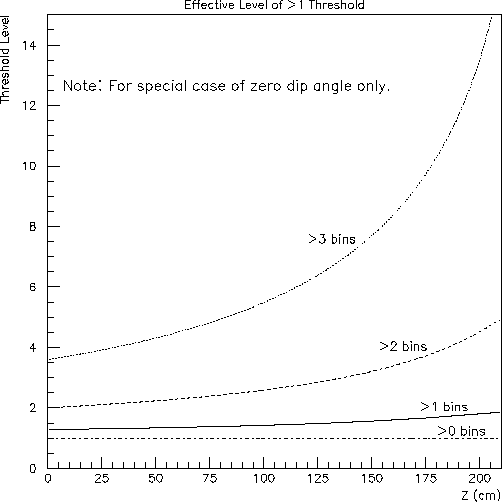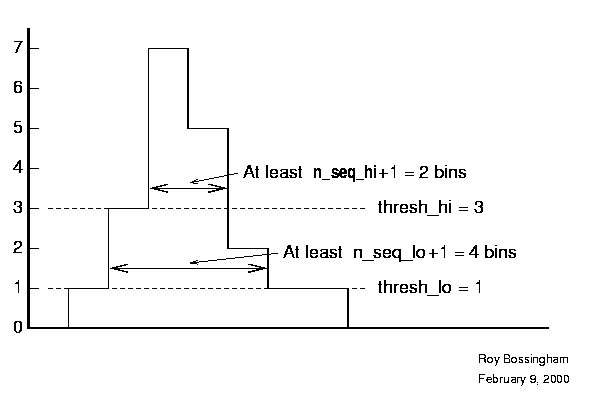
| STAR home | |
| DAQ ASIC Parameters Description | |
| Maintenance | |
| Last modified: 15:52 Thurs 24-Feb-2000 | |
There is no generally accepted convention for ordering these four parameters and they should always be named explicitly.
The DAQ ASIC is formally described in:
The main requirements for valid, zero-suppressed sequences are:
In early-mid Feb. 2000 and before, TPC people generally used a parameter ordering consistent with StDaqLib/GENERIC/RecHeaderFormats.hh :
struct ASIC_params
{
unsigned char thresh_lo;
unsigned char thresh_hi;
unsigned char n_seq_lo;
unsigned char n_seq_hi;
}
However, there is no standardized ordering within DAQ,
so one must always explicitly define the variables.
A method TPCV2P0_CPP_SR::getAsicParams(ASIC_params *), defined in TPCV2P0.hh, exists to retrieve the ASIC parameters used to take a data file. Mike Levine has supplied the following example (untested, but expected to work):
DetectorReader *dr = getDetectorReader(er, "TPCV2P0");
....
CPPReader *cppr = dr->getCPPReader(sector);
if(!cppr)
{
standard error stuff..
}
ASIC_Params *apms;
cppr->getAsicParams(&apms);
printf("low threshold %d\n",apms->thresh_lo);.....
In Dec. 1999 the ASIC requirement was:
(thresh_lo, thresh_hi, n_seq_lo, n_seq_hi) =
(1,3,3,1).
Requiring fewer bins would have been better for such cosmic-ray data,
since, in this case, hits having
short drift distances can also have small dip angles. There is then
little broadening in the time direction
from either diffusion or the dip angle and the edge pads of the hits
from a number of minimum-ionizing
tracks are lost. Documentation discussing the choice of reasonable
ASIC parameters is in progress, but
some minimal information appears below.
The time projection of a typical hit passing the Dec. 1999 ASIC requirement is:

The time bins passing the high threshold need not
be contiguous; the pulse below meets the same
(thresh_lo, thresh_hi, n_seq_lo, n_seq_hi) =
(1,3,3,1) requirement.
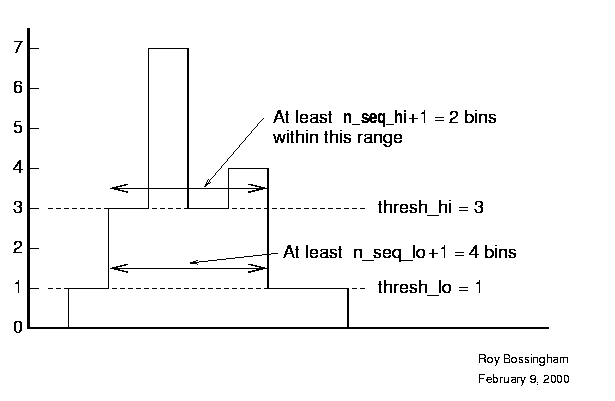
For a given drift gas, the time development of a TPC signal is largely determined by the amplifier shaping time, drift distance (longitudinal diffusion) and dip angle. For A-A collisions, drift distance and dip angle are highly correlated, but this is much less true for loosely triggered cosmic-ray data.
For such cosmic-ray data taken under the Dec. 2000 running conditions, and that happens to have small dip angles, there will be a strong correlation between a requirement on threshold and a requirement on the number of time bins above that threshold. The following plot shows an estimate of the relative effective threshold when multiple time bins are required. For large Z (short drift distance), the signals are so narrow in the time direction that requiring >2 or >3 time bins requires a much larger signal than does requiring >0 time bins. Typically, the ratio is as shown below:
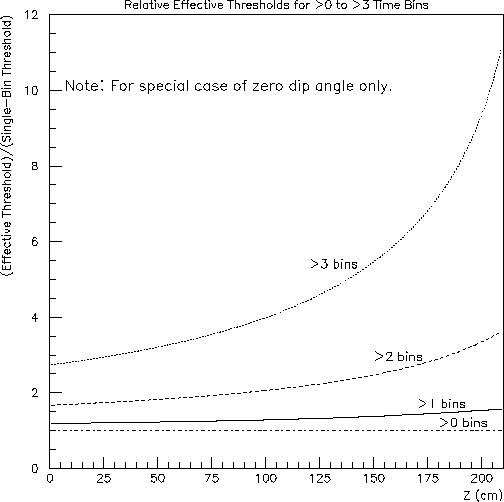
Properly calculated pedestals minimize digitization bias by causing an ADC to be assigned, on average, to the nearest integer value. Therefore, thresh_lo>0 is, on average, asking for a signal>0.5 ADC counts. Taking this into account for the specific case when thresh_lo>0, the effective thresholds for different time-bin requirements would typically become (were thresholds not discrete):
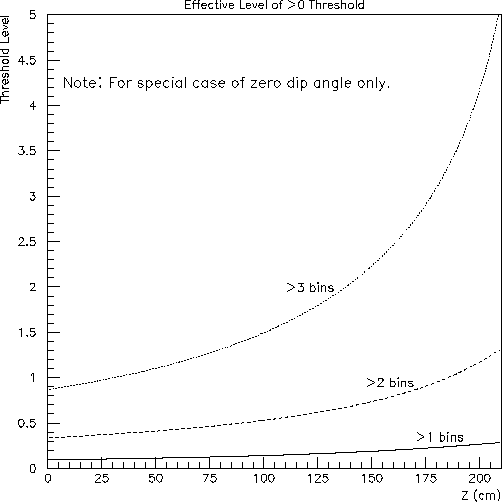
Alternatively, for the specific case when thresh_lo>1, the effective thresholds for different time-bin requirements would typically become (again, if thresholds were not discrete):
